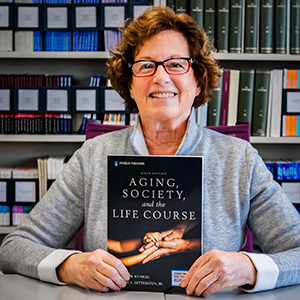"Aging, Society, and the Life Course" published

 Executive Director of Scripps Gerontology Center Dr. Suzanne Kunkel’s 3rd published book “Aging, Society, and the Life Course” hit bookshelves nationwide in 2021. The sixth edition has a stronger focus on diversity, equity and inclusion, and the ways in which structural factors help shape the opportunities and experiences of aging. We sat down with Dr. Kunkel to discuss her perspective on the book.
Executive Director of Scripps Gerontology Center Dr. Suzanne Kunkel’s 3rd published book “Aging, Society, and the Life Course” hit bookshelves nationwide in 2021. The sixth edition has a stronger focus on diversity, equity and inclusion, and the ways in which structural factors help shape the opportunities and experiences of aging. We sat down with Dr. Kunkel to discuss her perspective on the book.
What inspired you to write this book?
Bob Atchley—Director of Scripps from 1974 to 1998 and one of my mentors—had a vision for the first edition of this book, which we refined with feedback from educators and researchers in the field. This revision was inspired by significant changes in the field of gerontology including new generations of theories, lines of scholarship that have evolved to address new questions, concepts and innovations such as aging-in-place initiatives, diverse family structures within which aging people are situated, critiques of successful aging, and the notion of precarity.
How long has this book been in the works?
Do we have to talk about that? It's been about 2 years.
What was the biggest challenge you faced?
Time! For both my co-author (Rick Settersten) and me, we had to balance our enthusiasm for this book project with the demands of administrative positions, teaching, research, and other writing projects.
Can you talk about what it was like to co-author a book with Richard Settersten?
It was a total joy to work with Rick. He is a brilliant thinker, a leader in the field, a gifted writer, a respected colleague, and a dear friend. Throughout the reframing and writing of the book, we had an opportunity to think through and discuss lots of ideas, decide priorities for what were the most important new trends and ideas that needed to be incorporated, and keep each other focused on one of our major goals: how to make the book more accessible to students. Starting with input from some of our students, we worked hard together to write for students as the primary audience, rather than instructors who already had knowledge and commitment to the field. We shared a desire to help students see why gerontology and aging matter to them, and we worked together to make sure that goal was honored. It was a privilege to work with Rick on this massive project; I learned a lot from him and I appreciate the deepening of our relationship as colleagues that happened during this process.
What was/is the best part of writing this?
Writing a textbook is a great opportunity to read new things and get a fresh perspective on what is happening in the field. As noted above, it was also great to work with Rick. The previous editions were done with my colleague and friend, Leslie Morgan; I always appreciated her teaching and scholarship, and the ways that she helped me be a better writer (and more respectful of deadlines). Building on those positive experiences with Leslie, this collaboration with Rick opened some new doors for us.
What would you say to someone who was thinking about writing their own book?
Develop a good working relationship with your editor and your co-author. Make expectations clear and discuss your workstyles. Decide your highest priorities for what the book will accomplish.

